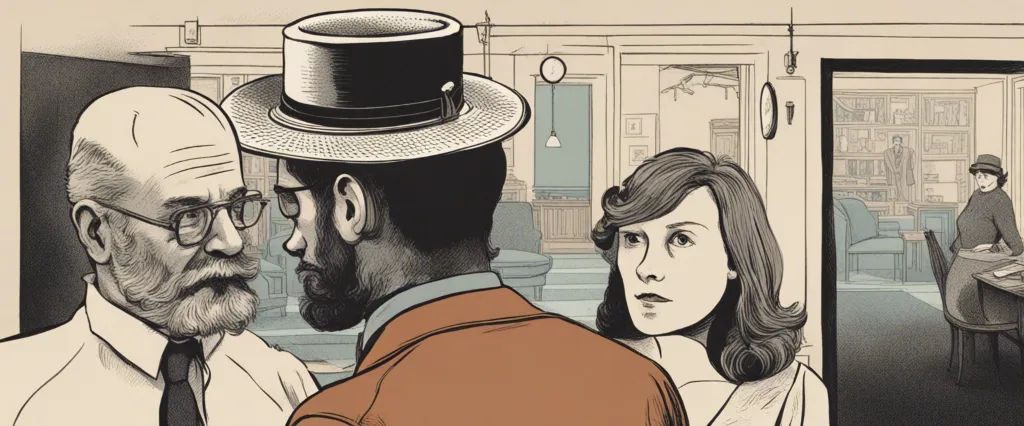“The Man Who Mistook His Wife for a Hat and Other Clinical Tales” delves into the captivating world of neurological disorders through a collection of intriguing case studies. Written by the renowned neurologist Oliver Sacks, this book offers a remarkable insight into the lives of individuals battling unusual brain conditions. Oliver Sacks, recognized as one of the most prominent figures in his field, dedicated his life to understanding the intricacies of the human mind and sharing his knowledge with the world. As both a compassionate physician and a gifted storyteller, Sacks’s writings not only educate but also captivate readers, providing a unique perspective into the complexities of the human brain.
Chapter 1: A Woman Wearing a Hat
Chapter 1 of “The Man Who Mistook His Wife for a Hat and Other Clinical Tales” by Oliver Sacks is titled “A Woman Wearing a Hat.” In this chapter, Sacks introduces us to Dr. P, a highly accomplished musician who is suffering from a neurological disorder.
Dr. P visits Sacks, seeking assistance with his perception problem. As the title implies, Dr. P has difficulty recognizing familiar objects, often mistaking them for something else entirely. This is exemplified when he mistakes his wife for a hat while trying to put his coat on. This phenomenon, known as visual agnosia, arises from a malfunction in the visual regions of his brain, causing him to lose the ability to accurately interpret visual stimuli.
Sacks discusses Dr. P’s case in depth, describing how the musician’s condition has progressively worsened. He explains the various tests and assessments he conducts to better understand Dr. P’s visual agnosia. Sacks discovers that although Dr. P cannot recognize faces, objects, or even his own reflection, he still possesses remarkable musical talent.
Through his interactions with Dr. P, Sacks emphasizes the importance of empathy and compassion in medical practice. He reflects on how the loss of perception affects not only Dr. P’s physical abilities but also his identity and sense of self. Despite his condition, the musician maintains a positive and resilient attitude, finding solace in his music.
In this introductory chapter, Sacks sets the stage for the captivating and poignant clinical tales that follow. He invites readers to ponder the complexities of the human brain and the extraordinary ways in which individuals cope with various neurological disorders.
Chapter 2: Trapped in a Static World
Chapter 2 of “The Man Who Mistook His Wife for a Hat and Other Clinical Tales” by Oliver Sacks is titled “Trapped in a Static World.” In this chapter, Dr. Sacks explores the case of a woman named Christina, who suffers from a neurological condition called “visual agnosia.”
Christina’s visual agnosia affects her perception and recognition of faces. She cannot identify her loved ones or even her own reflection in a mirror. Dr. Sacks describes how Christina attempts to navigate the world by using other visual cues such as clothing or hairstyles, but her lack of facial recognition often leads to moments of confusion and social embarrassment.
Through conversations with Christina, Dr. Sacks delves deeper into her condition and realizes that she not only struggles with facial recognition but also experiences a distorted sense of space and time. Christina explains that everything appears flat and frozen, like a photograph, causing her to struggle with depth perception and even the concept of motion.
Dr. Sacks relates Christina’s experiences to a condition known as “simultagnosia,” in which an individual’s visual field is broken down into isolated fragments, hindering their ability to perceive the whole picture. This condition, combined with her lack of facial recognition, creates a profound sense of isolation and disorientation for Christina.
Dr. Sacks concludes the chapter by reflecting on Christina’s immense courage in facing the challenges of her condition. He emphasizes the importance of understanding the subjective experiences of those with neurological disorders, as it not only provides valuable insights into the workings of the brain but also expands our understanding and empathy towards one another.
Chapter 3: The Fascinating Relationship between Music and the Brain
Chapter 3 of “The Man Who Mistook His Wife for a Hat and Other Clinical Tales” by Oliver Sacks explores the profound and captivating connection between music and the brain. Sacks begins the chapter by introducing Dr. P, a talented musician who suddenly lost his ability to recognize familiar faces and objects; he even attempted to wear his wife as a hat due to this visual agnosia.
However, despite his profound visual impairment, Dr. P’s appreciation and understanding of music remain intact. Relying heavily on auditory stimulation, Dr. P uses his musical sense to navigate the world around him. Sacks notes that Dr. P’s case illustrates how different sensory modalities have distinct neural mechanisms, highlighting the independence of his auditory and visual processing.
Furthermore, Sacks brings attention to the brain’s specialization for music processing. He discusses how different regions of the brain are involved in various aspects of music perception, such as rhythm and melody. Sacks presents cases of patients with localized brain damage, causing specific deficits in music recognition or production. One particular case involves a man who mistakenly believes that he is always listening to a song playing in his head, causing him significant distress.
Sacks also explores the mechanisms behind musical hallucinations, where individuals hear music that is not actually present. These hallucinations can result from a variety of factors, including hearing loss or brain damage. He emphasizes that these experiences highlight the intricate relationship between music and the brain, with the brain’s propensity for musical processing sometimes taking hold of our auditory perception.
Overall, Chapter 3 delves into the extraordinary relationship between music and the brain, demonstrating how music can both transcend and be affected by neurological impairments. Through various clinical tales, Sacks showcases the powerful influence of music on our cognitive and emotional states, providing an intriguing perspective on the intersection of music and neuroscience.
Chapter 4: Losing the Sense of the Body

Chapter 4 of “The Man Who Mistook His Wife for a Hat and Other Clinical Tales” is titled “Losing the Sense of the Body.” In this chapter, Oliver Sacks explores the fascinating case of patients who have lost their sense of proprioception.
Sacks begins by introducing us to two patients, Mr. MacGregor and Mrs. O’C. Both individuals have lost the ability to perceive their own bodies in space. While they are fully aware of their limbs, they are unable to locate them without visual cues and have difficulty coordinating their movements.
Mr. MacGregor, a former boxer, describes feeling like a mechanical man, unable to control his own body. He relies heavily on his visual senses to perform basic tasks like walking, reaching, and even sitting down. Mrs. O’C, on the other hand, feels as though her right side does not belong to her and is constantly bumping into objects.
As Sacks investigates further, he discovers that both patients have lost their proprioceptive sense due to damage in their brains. He explains how proprioception is essential for our basic motor functions and how the lack of this sense leads to a distorted body perception.
Sacks also touches upon the concept of phantom limbs, where patients feel sensations or pain in limbs that have been amputated. In this chapter, he highlights a man with a phantom limb that is positioned incorrectly due to the proprioceptive system’s disruption.
Overall, Chapter 4 delves into the implications of losing one’s sense of proprioception, illuminating the crucial role it plays in our everyday movements and our perception of our own bodies. It offers a poignant look at how the brain’s intricate networks can result in profound changes in an individual’s lived experience.
Chapter 5: The Loss of Time
Chapter 5 of “The Man Who Mistook His Wife for a Hat and Other Clinical Tales” by Oliver Sacks is titled “The Loss of Time.” This chapter explores the case of Mr. Thompson, a former soldier who suffered from severe amnesia after a World War I injury.
Mr. Thompson’s amnesia was unique in that he was unable to retain any new memories beyond a few seconds. Every time he encountered a person or an object, it was as if he were seeing it for the first time. This condition is known as “anterograde amnesia,” wherein a person loses the ability to form new memories.
Sacks observed Mr. Thompson’s struggle to maintain a functional life within his limited memory span. He noted that, to cope with his amnesia, Mr. Thompson relied heavily on his wife, who remained a constant figure in his life. However, this dependency caused Mr. Thompson to occasionally mistake his wife for a hat, struggling to process her face as a whole and instead focusing on individual features.
Sacks explored the profound implications of Mr. Thompson’s condition, reflecting on the role of memory in our sense of self and continuity in life. He highlighted the importance of memory in our ability to learn, adapt, and make sense of the world around us.
Through this case study, Sacks touched upon the concept of time and how it is intricately intertwined with memory. Mr. Thompson’s inability to form new memories meant he could not perceive the passage of time, living in an eternal present.
In summary, Chapter 5 delves into the unique case of Mr. Thompson and his struggle with anterograde amnesia, illustrating the profound impact that the loss of time and memory can have on an individual’s perception of the world, personal relationships, and overall sense of self.
Chapter 6: Unusual Brain Structures
Chapter 6 of “The Man Who Mistook His Wife for a Hat and Other Clinical Tales” by Oliver Sacks focuses on unusual brain structures observed in some of the author’s patients. Sacks delves into the intriguing case studies of three individuals: Dr. P., Mr. B, and Mrs. O’C.
Dr. P., a music professor, was experiencing a puzzling condition known as “agnosia,” in which he was unable to recognize familiar objects including his own wife’s face. Sacks attributes this difficulty to a specific brain impairment that hindered Dr. P.’s ability to form a complete visual gestalt. Surprisingly, Dr. P. showed an exceptional inclination for music and possessed a unique talent for coping with his visual deficits by relying heavily on auditory cues.
Mr. B., on the other hand, suffered from a severe memory disorder. His ability to form new memories lasted only a few seconds, resulting in a never-ending present experience. Sacks explores the possibility that this condition, called “anterograde amnesia,” stemmed from damage to a part of Mr. B’s brain called the hippocampus. Despite his crippling condition, Mr. B. exhibited an interesting ability to play piano beautifully without the awareness that he had learned the instrument.
Lastly, Sacks presents the intriguing case of Mrs. O’C., who could experience intense and vivid emotional and visual hallucinations at will. These hallucinations were often triggered by music or movement. Sacks proposes that this phenomenon could be related to a combination of migraines, a particularly active limbic system, and a vivid imagination.
Through these case studies, Sacks highlights the complexity and uniqueness of the human brain. Each individual’s condition provides a glimpse into the intricate connections between brain structures and their influence on perception, memory, and emotion. Sacks’ narratives serve as windows into the fascinating and mysterious world of neurology, inspiring both awe and curiosity.
Chapter 7: The Maze of Memory
Chapter 7: “The Maze of Memory” in the book “The Man Who Mistook His Wife for a Hat and Other Clinical Tales” by Oliver Sacks explores the fascinating realm of memory disorders and their profound impact on individuals’ lives.
The chapter begins by introducing the case of Jimmy G., a retired sailor who suffered severe amnesia after a viral infection of the brain. Jimmy’s amnesia left him trapped in a psychological present, constantly living in the moment as he could only remember a few seconds of his past. He was eternally confused and disoriented, unable to form new memories or recall his past experiences, as if trapped within a labyrinth where every turn led to the same place.
Sacks discusses the various forms of amnesia, including anterograde amnesia (inability to form new memories) and retrograde amnesia (loss of existing memories). He delves into the scientific understanding of memory and explains the role of the hippocampus, a vital structure for memory consolidation, comparing it to a librarian who organizes and stores memories.
The chapter also delves into other cases, such as Clive W., a talented musician who lost his ability to form new memories due to a viral infection. Despite his significant memory loss, Clive could still play his piano pieces flawlessly, indicating the preservation of procedural memory, which involves learned skills and abilities.
Sacks emphasizes the fundamental role of memory in shaping our identities and its tragic loss for individuals like Jimmy and Clive. The cases described in this chapter reveal the complex interplay between memory and other cognitive functions, highlighting both the importance of memory in our lives and the mysterious workings of the human mind.

Chapter 8: The Remarkable Brain’s Adaptability
Chapter 8: The Remarkable Brain’s Adaptability of “The Man Who Mistook His Wife for a Hat and Other Clinical Tales” by Oliver Sacks delves into the incredible adaptability and plasticity of the human brain, demonstrated through a series of fascinating clinical case studies.
Sacks begins by introducing us to Dr. P, a distinguished pianist suffering from focal dystonia, a condition causing excessive muscle contractions in his right hand, making it impossible for him to control his fingers individually. Despite this debilitating condition, Dr. P discovers that he is able to play complex piano pieces flawlessly when playing two separate melodies simultaneously. This unexpected talent emerged from his brain’s ability to adapt and bypass the damaged connection, reorganizing its functions to compensate for the loss.
The chapter also explores the case of Christina, a young girl who developed a rare visual condition called amblyopia or “lazy eye.” Despite her left eye’s almost complete blindness, Christina’s brain compensates for this by enhancing her right eye’s visual acuity to an extraordinary degree. Sacks notes that her brain underwent a remarkable period of plasticity during her early childhood, leading to the strengthening of neural connections in her functioning eye.
Sacks further discusses the phenomenon of phantom limbs, where individuals continue to experience sensations and even pain in a limb that has been amputated. He examines the intriguing case of Mrs. K, who feels a persistent itch in her amputated right leg. Through careful experimentation, Sacks discovers that the sensations are connected to areas of her brain responsible for processing sensory information from her missing limb. The brain has adapted and occupied these areas with new functions, causing sensory signals to become crossed.
Overall, Chapter 8 explores the fascinating and adaptive nature of the human brain. Through the presented cases, Sacks highlights the brain’s remarkable ability to reorganize itself to overcome adversity, demonstrating the boundless potential within our neural networks.
After Reading
In “The Man Who Mistook His Wife for a Hat and Other Clinical Tales” by Oliver Sacks, the author presents a collection of captivating and thought-provoking stories about various neurological disorders. Through these tales, Sacks emphasizes the intricate relationship between the human brain and our perception of reality. With compassion, clarity, and vivid storytelling, he invites readers to explore the depths of the human mind and contemplate the profound impact these disorders have on individual lives. A true testament to the resilience of the human spirit, this book serves as a reminder that our understanding of the mind is still ever-evolving, and its complexities continue to fascinate and baffle us.
1. The Emperor of All Maladies: A Biography of Cancer” by Siddhartha Mukherjee – Similar to Oliver Sacks’ book, this Pulitzer Prize-winning work dives into the world of medicine and tells captivating stories of patients battling cancer. Mukherjee explores the history, scientific advancements, and personal struggles, providing a compelling narrative that educates and humanizes the disease.
2. Being Mortal: Medicine and What Matters in the End” by Atul Gawande – In this thought-provoking book, Gawande reflects on his experiences as a surgeon and explores the difficult decisions faced by both patients and doctors in end-of-life care. Like Oliver Sacks, Gawande reveals the humanity behind medicine, emphasizing the importance of quality of life and dignity in our final days.
3. The Immortal Life of Henrietta Lacks” by Rebecca Skloot – This intriguing non-fiction book tells the story of Henrietta Lacks, an African American woman whose cells were taken without her consent and have since been used in numerous scientific discoveries. Skloot delves into the ethical implications of medical research, highlighting the often-forgotten individuals behind groundbreaking scientific advancements.
4. When Breath Becomes Air” by Paul Kalanithi – This memoir chronicles Kalanithi’s journey from being a neurosurgeon to becoming a patient himself after being diagnosed with terminal lung cancer. Like Oliver Sacks’ work, this book invites readers into the world of medicine while exploring the profound questions about life, death, and meaning.
5. “The Ghost Map: The Story of London’s Most Terrifying Epidemic – and How It Changed Science, Cities, and the Modern World” by Steven Johnson – In a similar vein to Oliver Sacks’ books, “The Ghost Map” focuses on the intersection of medicine, science, and human stories. Johnson vividly describes the 1854 cholera epidemic in London and the efforts of physician John Snow to trace the source of the disease. This book explores the cultural, historical, and scientific significance of this pivotal moment in medical history.




